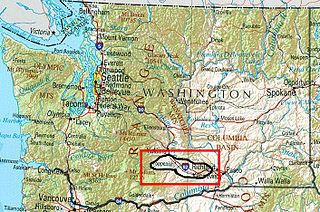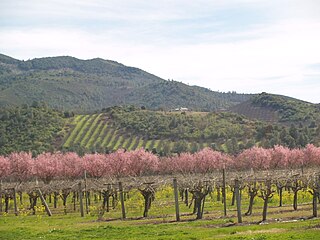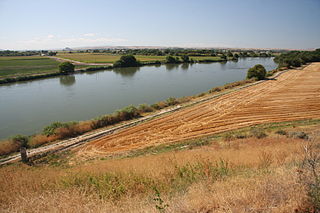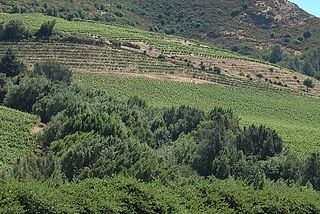Related Research Articles

Washington wine is a wine produced from grape varieties grown in the U.S. state of Washington. Washington ranks second in the United States in the production of wine. By 2017, the state had over 55,000 acres (220 km2) of vineyards, a harvest of 229,000 short tons (208,000 t) of grapes, and exports going to over 40 countries around the world from the 940+ wineries located in the state. While there are some viticultural activities in the cooler, wetter western half of the state, the majority (99.9%) of wine grape production takes place in the shrub-steppe eastern half. The rain shadow of the Cascade Range leaves the Columbia River Basin with around 8 inches (200 mm) of annual rain fall, making irrigation and water rights of paramount interest to the Washington wine industry. Viticulture in the state is also influenced by long sunlight hours and consistent temperatures.
The state of Oregon in the United States has established an international reputation for its production of wine, ranking fourth in the country behind California, Washington, and New York. Oregon has several different growing regions within the state's borders that are well-suited to the cultivation of grapes; additional regions straddle the border between Oregon and the states of Washington and Idaho. Wine making dates back to pioneer times in the 1840s, with commercial production beginning in the 1960s.

Yakima Valley is the first American Viticultural Area (AVA) established within Washington state, gaining the recognition on May 4, 1983. Within the vast Columbia Valley AVA, Yakima Valley appellation cultivates more than 53,000 acres (21,448 ha) giving the region the largest concentration of wineries and vineyards in the state. The most widely planted varietals in the area are Chardonnay, Riesling, Merlot, Cabernet Sauvignon, Pinot gris, and Syrah. Nearly 40% of Washington's annual wine production is made from Yakima Valley grapes. In addition to grapes, the Yakima Valley is also home to several fruit orchards growing apples, cherries, nectarines, peaches, pears and plums. Around the town of Zillah, there is the Zillah Fruit Loop driving tour through the area's orchards and vineyards. The area is also home to nearly 80% of the US hop production.

Walla Walla Valley is an American Viticultural Area (AVA) located within Washington state and extending partly into the northeastern corner of Oregon. The wine region is entirely included within the larger Columbia Valley AVA. In addition to grapes, the area produces sweet onions, wheat and strawberries After the Yakima Valley AVA, the Walla Walla AVA has the second highest concentration of vineyards and wineries in Washington State. Walla Walla hosts about 140 wineries.

Idaho wine refers to wine produced in the state of Idaho. Idaho has a long history of wine production with the first vineyards in the Pacific Northwest being planted here in the 1860s. Prohibition virtually wiped out the Idaho wine industry in the early 20th Century, but was resurrected in the 1970s. Today, Idaho's viticulture is its fastest growing agricultural industry.

The Snake River Valley is an American Viticultural Area (AVA) that encompasses an area in Southwestern Idaho and two counties in eastern Oregon. The Idaho Grape Growers and Wine Producers Commission and the Idaho Department of Commerce and Labor filed the petition to recognize the AVA, and it was granted in 2007.

Paso Robles is the third American Viticultural Area (AVA) located in San Luis Obispo (SLO) County, California. It was established by the Bureau of Alcohol, Tobacco and Firearms (ATF), Treasury on November 3, 1983 based on a petition submitted by Martin-Brothers Winery. The area encompasses 609,673 acres (953 sq mi) with approximately 18,500 acres (7,487 ha) cultivated with wine grapes known for their heritage varietal Zinfandel, Cabernet Sauvignon, and Rhône-style wines.
The Ohio River Valley AVA is an American Viticultural Area centered on the Ohio River and surrounding areas. It is the second largest wine appellation of origin in the United States with 16,640,000 acres (26,000 sq mi) (67,300 km2) in portions of the states of Indiana, Kentucky, Ohio and West Virginia. The area is mostly planted with hybrid grapes like Baco noir, Marechal Foch, Seyval blanc and Vidal. Of the Vitis vinifera found in the area Cabernet Franc, Cabernet Sauvignon, Chardonnay, Petit Manseng and Riesling are the most common. The AVA size was decreased by approximately 1,530 square miles when the Indiana Uplands AVA was established in 2013 composed of the bordering area in Indiana.

Sierra Foothills is a vast American Viticultural Area (AVA) encompassing the foothill "belt" of the Sierra Nevada in north-central California, United States. It was established on December 18, 1987 by the Bureau of Alcohol, Tobacco and Firearms (ATF), Treasury after evaluating the petition filed by the Sierra Foothills Winery Association of Somerset, California for the establishment of a "Sierra Foothills" viticultural area in portions of Yuba, Nevada, Placer, El Dorado, Amador, Calaveras, Tuolumne and Mariposa Counties. Wine grapes were introduced to the area in the nineteenth century during the California Gold Rush. Over 280 vineyards/wineries are located within its boundaries.

Lake County wine is a appellation that designates wine made from grapes grown mostly in Lake County, California and located north of Napa County. Although each region within Lake County has unique viticultural attributes, all are influenced by Clear Lake, the largest inland body of water in California. County names in the United States automatically qualify as legal appellations of origin for wine produced from grapes grown in that county and do not require registration with the Alcohol and Tobacco Tax and Trade Bureau (TTB). TTB was created in January 2003, when the Bureau of Alcohol, Tobacco and Firearms, or ATF, was extensively reorganized under the provisions of the Homeland Security Act of 2002.

Sta. Rita Hills is an American Viticultural Area located in Santa Barbara County, California. From its creation in 2001 through 2006, the wine appellation was officially named Santa Rita Hills AVA. The formal name change was the result of a protest by and subsequent negotiations with Vina Santa Rita, a very large Chilean wine producer that was concerned about the AVA name diluting its international brand value. The name change took effect on January 5, 2006, with a yearlong period for producers in the AVA to change their wine labels. In 2016, TTB expanded the approximately 33,380 acres (52 sq mi) “Sta. Rita Hills” viticultural area by approximately 2,296 acres (4 sq mi).
Snipes Mountain is an American Viticultural Area (AVA) located in the Yakima Valley of Washington state. It was established by the Alcohol and Tobacco Tax and Trade Bureau {TTB), Treasury on January 21, 2009 as the state's 10th AVA. It is the second smallest AVA in the state, after the Red Mountain AVA, and has one of the state's longest viticultural histories. The 4,145 acres (6 sq mi) appellation is a sub-AVA of the Yakima Valley AVA and the Columbia Valley AVA. It is located above and between the towns of Sunnyside and Granger around Outlook, Washington, in the southeast corner of the Yakima Valley.

Naches Heights is an American Viticultural Area (AVA) contained within the Columbia Valley AVA. The AVA was recognized officially on January 13, 2012. Additionally, it is the first AVA in Washington state to be fully sustainable, with all 7 vineyards practicing in either biodynamic or LIVE certification. It is the smallest AVA in Washington with 37.2 acres (15.1 ha) planted.

Eagle Foothills is the second American Viticultural Area (AVA) in the state of Idaho located in the southwestern region in Gem and Ada Counties. The area lies southeast of Emmett, north of Eagle and approximately 10 miles (16 km) northwest of the city of Boise. It was established on December 28, 2015 by the Alcohol and Tobacco Tax and Trade Bureau (TTB), Treasury as the first sub-appellation in the vast Snake River Valley viticultural area and the first appellation entirely within Idaho’s state borders. It does not overlap with any existing or proposed AVA. Eagle Foothills lies at the north bank of Ancient Lake Idaho with its elevations ranging from 2,490 to 3,412 feet (759–1,040 m). The area encompasses 49,815 acres (78 sq mi) with nearly 70 acres (28 ha) under vine with plans to add 472 acres (191 ha) and seven vineyards. Its USDA plant hardiness zones are 7a and 7b. Vineyard elevations are below 3,000 feet (914 m). The majority of viticulture activity is at 3 Horse Ranch Vineyards with its 46 acres (19 ha) in center of the appellation. The cool climate and relatively short growing season are suitable for growing early to mid-season varietals such as Chardonnay, Pinot Gris and Riesling.

Petaluma Gap is an American Viticultural Area (AVA) established on January 8, 2018 by the Alcohol and Tobacco Tax and Trade Bureau (TTB), Treasury. The area spans 202,476 acres (316 sq mi) stretching through an 30 miles (48 km) inland valley from the Pacific coast at Bodega Bay southeast to Highway 37 at Sears Point on San Pablo Bay straddling the border of northern Marin and southern Sonoma counties. The AVA lies entirely within the North Coast AVA and partially in the Sonoma Coast AVA with eighty commercially-producing vineyards cultivating 4,000 acres (1,619 ha) and nine bonded wineries. The wind gap in its coastal mountain range funnels cooling breezes and fog east from the Pacific Ocean through the city of Petaluma to San Pablo Bay. A persistent afternoon breeze causes lower grape yields and longer hang time contributes to the AVA vintages' unique flavors and fruit characteristics which defines their character and distinction.
Los Olivos District AVA is an American Viticultural Area located in Santa Barbara County, California established on January 20, 2016, by the Alcohol and Tobacco Tax and Trade Bureau (TTB). It straddles the Santa Ynez Valley, formed by the Santa Ynez River, between the Purisima Hills above Solvang. The area encompasses the townships of Los Olivos, Ballard, Santa Ynez and Solvang. State Route 154, known locally as the San Marcos Pass Road or Chumash Highway, bisects the region accessing many of the wineries and vineyards as it traverses toward its destination in Santa Barbara.

Moon Mountain District Sonoma County is an American Viticultural Area (AVA) within Sonoma Valley and North Coast viticultural areas, just north of the city of Sonoma. This mountainous region on the very eastern edge of Sonoma County has a historic reputation for producing rich, intensely-flavored wines from Cabernet Sauvignon and Syrah varietals since the 1880s. The District was established on November 1, 2013, by the Alcohol and Tobacco Tax and Trade Bureau (TTB). Its designation covers 17,663 acres (28 sq mi) of land stretching north-south along the western slopes of the Mayacamas mountains between Sugarloaf Ridge State Park and Los Carneros viticultural area with the Napa Valley’s Mount Veeder viticultural area outlining the eastern slopes. Its name is derived from Moon Mountain Road, which traverses through the area and itself a reference to Sonoma, which means 'valley of the moon' in the local Native American dialect. A clear view to San Francisco 50 miles (80 km) south is not uncommon from Moon Mountain District vineyards.
Alisos Canyon is an American Viticultural Area (AVA), located in Santa Barbara County, California due east outside the small town of Los Alamos on U.S 101 and about 20 miles (32 km) south of Santa Maria, was established on August 25, 2020, by the Alcohol and Tobacco Tax and Trade Bureau (TTB). Alisos Canyon stretches west to east over 9 square miles with one bonded winery and nine commercially-producing vineyards cultivates on approximately 238 acres (96 ha). Alisos Canyon Road bisects the region accessing many of its vineyards. The USDA plant hardiness zone for the AVA is 7b.

Santa Barbara County wine is an appellation that designates wine made from grapes grown mostly in Santa Barbara County, California which is located approximately 50 miles (80 km) north of Los Angeles County. County names in the United States automatically qualify as legal appellations of origin for wine produced from grapes grown in that county and do not require registration with the Alcohol and Tobacco Tax and Trade Bureau (TTB) of the Treasury Department. TTB was created in January 2003, when the Bureau of Alcohol, Tobacco and Firearms, or ATF, was extensively reorganized under the provisions of the Homeland Security Act of 2002.

Monterey County wine is a appellation that designates wine made from grapes grown in Monterey County, California which lies entirely within the expansive multi-county Central Coast viticultural area. County names in the United States automatically qualify as legal appellations of origin for wine produced from grapes grown in that county and do not require registration with the Alcohol and Tobacco Tax and Trade Bureau (TTB). TTB was created in January 2003, when the Bureau of Alcohol, Tobacco and Firearms, or ATF, was extensively reorganized under the provisions of the Homeland Security Act of 2002.
References
- 1 2 "Establishment of the Lewis-Clark Valley Viticultural Area and Realignment of the Columbia Valley Viticultural Area" (27 CFR 9 [Docket No. TTB–2015–0005; T.D. TTB–136; Ref: Notice Nos. 149 & 149A] RIN 1513–AC14 Final rule). Federal Register . Alcohol and Tobacco Tax and Trade Bureau (TTB), Treasury. 81 (76): 23156–23162. April 20, 2016. Archived (PDF) from the original on April 17, 2023. Retrieved May 25, 2020.
 This article incorporates text from this source, which is in the public domain.
This article incorporates text from this source, which is in the public domain. - 1 2 3 4 5 "Region". Lewis Clark Valley Wine Alliance. 2016.
- 1 2 3 4 5 "Lewis‐Clark Valley Named Newest American Viticultural Area". Lewis Clark Valley Wine Alliance. Idaho. 2016. Retrieved May 25, 2020.
- ↑ "Idaho Wineries, Wines and Wine Country". Wines Northwest. 2016. Retrieved May 26, 2020.
- ↑ "Vineyards – Varietals Grown". Lewis Clark Valley Wine Alliance. 2016.